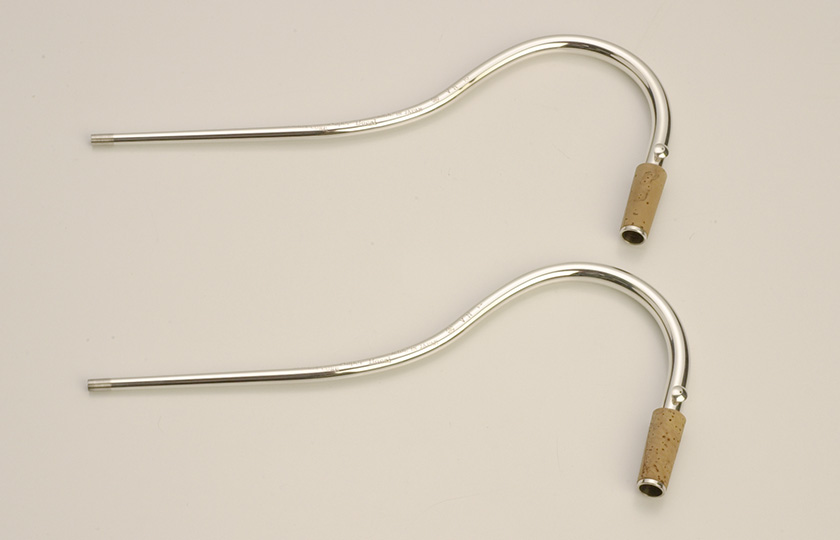The Structure of the Bassoon
The Bocal and its Various Functions
Is the bocal something to do with the voice?
The origins of the bassoon are the same as those of the oboe; the double reed. Sound waves are produced as the two parts of the reed quickly open and close. However, an oboe reed is attached to a short piece of metal, but a bassoon reed is made completely of the reed itself, and is inserted into the long metal tube of the bocal before being used to produce sound. Although it is called a bocal, it is not a "vocal." It is called a bocal to indicate that it is the mouthpiece. For all wind instruments it is necessary to have a part that functions close to the mouth, and the bocal with its reed in place is one particularly important part of the instrument.
Changes to the timbre depending on the bocal
Most players carry a number of bocals. The sensation of blowing into the instrument also varies depending on the bocal, with high pitch notes and soft, "pianissimo" sounds becoming easier to play and the timbre becoming gentler. There are some musicians who carry several tens of bocals so that they can select one that is appropriate to the music they intend to play.
To explain where the difference in timbre originates with different bocals, it could be said that the most important factor is the degree to which the tube widens inside, known as the bocal's taper angle. The bocal is a conical tube, the inner diameter of which gradually widens from about 4 millimeters at the end where the reed is inserted to around 10 millimeters where it is attached to the main body of the instrument, but can be varied in a number of ways depending on the nature of that widening. As it is difficult to play high-pitched notes on the bassoon, bocals specifically for this purpose seem very popular.
Tuning after changing the bocal?
When you buy a bassoon, two bocals of the same shape but of different lengths are generally provided. Usually when these two are included, the first, numbered "1," is the shorter and the second, numbered "2," is the longer. In Europe sometimes No. 0 and No. 1 bocals are used, with No. 0 being shorter than No. 1. A No. 00 bocal is even shorter than a No. 0, while conversely, those numbered "3" or "4" are made bigger so are longer.
The preparation of a number of bocals of different lengths is for the sake of tuning, or precise adjustments of the instrument's pitch. Tuning is performed by changing the length of the bore on both the clarinet and the flute, by adjusting the barrel and the head joint respectively, but the structure of the bassoon is complex and doesn't really include a part that can be extended. For this reason, tuning is performed by changing the length of the bocal that is inserted into the instrument. For example, a long bocal can be used during hot periods, which cause the instrument's pitch to become naturally higher, and a short bocal can be used when low temperatures lower the instrument's pitch.

Above, a No. 1 bocal, and below, a No. 2 bocal, which is longer
If your bocal is bent
If the instrument falls over, sometimes the bocal becomes bent and damaged.
If the tip becomes bent by just a few millimeters a fix can be made, but if it is bent into an angle it's likely to be impossible to repair the part completely. Even if it can be restored to approximate its former shape, the interior will certainly have been warped.
Musical Instrument Guide : Bassoon Contents
Structure
- What Kind of Musical Instrument is a Bassoon?
- A Long Tube that can be Separated
- The Bocal and its Various Functions
- Unique Features of the bassoon, and How to Play
- [Experiment1]Comparing the Sound of Tone Holes cut Obliquely and Perpendicular
- [Experiment2]Encasing the Bore in Various Materials
- Bonus Experiment
How to Play
How the Instrument is Made
Choosing an Instrument
Trivia
- An Instrument that is Sensitive to Humidity
- Sounds from water in the U-tube?
- There's a needle in the bocal?!
- Comments by conductors caused popularity to tumble?
- Bassoon classics - Chamber music works
- Bassoon classics - Concertos
- Is the "contra-fagotto" a contrabassoon?
- What is the best tool to file a reed?
